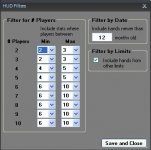thepokerkid123
Visionary
Silver Level
I'm a not-terrible (i.e. winning) cash game player and I have hardly played a SNG since before I had any idea what I was doing.
I'm looking to play some SNGs on the side but don't really know how to approach it.
1) What does a SNG player have to know to to not suck at SNGs? (i.e. what makes you better than your opponents?)
2) Early stages of SNGs feel like a cash game to me, is it really good advice to play tight or can I do high variance implied odds/fold equity stuff? (examples: light 3betting or expensive draws with big implied odds)
3) Should I be thinking more about my stack size or pot odds? I mean, assuming my tournament life isn't immediately on the line, should I ever fold because of stack size if my hand can be played profitably?
4) At what M should I accept/decline coinflips? An explanation would help a lot on this one.
5) In the late stages, what cards am I looking for? I know this is M and position dependent, but give me a broad answer, if you can. I mean, are weak broadway cards better or small PP or Ace-rag? My assumption is that I should play for stacks sooner with 22 than something like KJ, and Ax I'm not sure if it's better than 22 or not.
6) Finally, ICM...
I know what it is, I know why it's important, I know nothing more than that.
How much do I need to know to win at the smallest SNGs I can find?
And since it's something that you calculate away from the table, what is the most important stuff to figure out first?
If anyone actually answers all of this, thank you, it will be very much appreciated.
I'm looking to play some SNGs on the side but don't really know how to approach it.
1) What does a SNG player have to know to to not suck at SNGs? (i.e. what makes you better than your opponents?)
2) Early stages of SNGs feel like a cash game to me, is it really good advice to play tight or can I do high variance implied odds/fold equity stuff? (examples: light 3betting or expensive draws with big implied odds)
3) Should I be thinking more about my stack size or pot odds? I mean, assuming my tournament life isn't immediately on the line, should I ever fold because of stack size if my hand can be played profitably?
4) At what M should I accept/decline coinflips? An explanation would help a lot on this one.
5) In the late stages, what cards am I looking for? I know this is M and position dependent, but give me a broad answer, if you can. I mean, are weak broadway cards better or small PP or Ace-rag? My assumption is that I should play for stacks sooner with 22 than something like KJ, and Ax I'm not sure if it's better than 22 or not.
6) Finally, ICM...
I know what it is, I know why it's important, I know nothing more than that.
How much do I need to know to win at the smallest SNGs I can find?
And since it's something that you calculate away from the table, what is the most important stuff to figure out first?
If anyone actually answers all of this, thank you, it will be very much appreciated.










